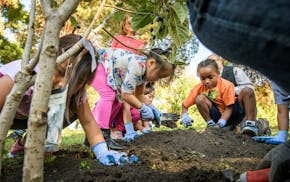Maybe not since the Pig War has a San Juan Islands farmer caused such a rhubarb. Of course, that little 19th century border dispute didn't get a lot of press beyond the swirling kelp beds of Rosario Strait. The only casualty was when American farmer Lyman Cutler shot a British hog that had rooted in his garden.
In 2012, a farmer in the off-the-beaten-track archipelago fired another shot — purely a political one this time — in the form of a citizen initiative. Like the first skirmish, it raised few eyebrows. But it might help shape Northwest agriculture.
In the same election that brought same-sex marriage and legal marijuana to Washington state, little San Juan County, with its 12,019 registered voters, passed an initiative banning the growing of GMO crops on its islands.
But stopping cultivation of GMOs with a citizen initiative is a bit like sticking your finger in a dike that's been carpet bombed. Engineered crops already flood the planet.
Last year, farmers grew GMOs on 430 million acres worldwide — 40 percent in the United States. Because of regulations and development costs, most GMOs remain confined to large commercial crops such as soybeans, cotton, corn and canola. Smaller GMO crops include sugar beets, squash, papayas, tomatoes, peppers and even petunias.
Depending on who's talking, either GMOs will save the world from climate change and feed humanity — all 9.6 billion of us, as projected by 2050 — or they'll corrupt the natural order and bring the "Silent Spring" that much sooner.
From San Juan County the crop ban has spread to Oregon, where two counties passed bans in May. In the past year lawmakers in Connecticut, Maine and Vermont passed measures aimed at labeling GMO foods.
Labeling is the same issue that last fall in Washington state generated a record $21 million "no" campaign — bankrolled by such large companies as Monsanto and Coca-Cola — before 51 percent of voters rejected the idea (the same margin as in California a year earlier). The defeat was even narrower this month in Oregon, where the issue again attracted record spending.
Polls by the New York Times in 2013 and ABC News in June both found that 93 percent of Americans favor labeling GMO foods.
When Lopez Islander Ken Akopiantz filed his San Juan County initiative in 2012, he just wanted to protect the purity of bucolic spreads such as his Horse Drawn Farm, reached down a long, wild rose-lined gravel drive off lonely Port Stanley Road.
On the way to Akopiantz's farm you pass Less Traveled Road and Wild Goose Chase Way. Turn up the drive and roll past sheep to a house sided with old shingles and tar paper.
An outhouse holds a composting toilet. From a towering gray barn, roosters crow and a horse whinnies. A serve-yourself stand offers wares from striped Delicata squash to frozen pork.
Akopiantz appears from down the driveway at the reins of a pair of strapping Belgian draft horses pulling a merrily jingling disc plow. It is protection of such traditional farming that motivated Akopiantz, 48, to propose the GMO ban.
A Connecticut native who came to the San Juans 15 years ago, he doesn't rant about GMO foods causing two-headed babies. He worries about practical issues, such as what happens if GMO crops are grown next door and spread into his field, corrupting foods he aims to sell as natural or organic?
He has reason to worry. Akopiantz drew his inspiration from Saskatchewan canola farmer Percy Schmeiser's 2011 visit to Lopez. Schmeiser became a crusader for anti-GMO independent farmers when he locked horns in the late 1990s with Monsanto. The GMO giant, which gave $5.3 million to fight the Washington labeling law, was the creator of Roundup Ready Canola, which other farmers grew on fields near Schmeiser's. ("Roundup Ready" means farmers can douse a crop with the potent herbicide and, thanks to genetic tinkering, only undesired weeds will wither.)
"The control of the seed supply is getting so consolidated," Akopiantz said. "Now it's happening that if that [GMO] crop contaminates someone else's field, they say your crop is theirs. If you're an organic producer, it's not the same crop you planted."
Tom Davis, government-relations director for the 41,000-member Washington Farm Bureau, said his group favors a statewide policy, but it hasn't come up in Olympia, the state capital. His membership is divided on growing GMOs.
"A successful farmer is one who grows crops well but also grows crops people want. Our members face a choice of a higher survival rate and higher crop yields with GMOs versus whether consumers want GMO foods."
Davis concedes that many are cynical about genetic engineering. "But over 600 peer-reviewed scientific studies show GMO food products are as safe to eat as conventionally grown food products."
Yet the Union of Concerned Scientists warns about the potential for new allergens, and San Juan Island's Bruce Gregory cites the creation of "superweeds" immune to Roundup. "Repeated use creates problems for other plants. There are issues here nobody has brought to the forefront."
Two years after passage of his initiative, Ken Akopiantz isn't doing anything much different. If the San Juan law helps change the outside world, it seems of only minor concern to him. Ninety-five percent of what he grows on Lopez stays on Lopez. He and his wife, Kathryn, like it that way. "We don't like going anywhere else," he said.

In Australia, 'cats are just catastrophic'
A climate-minded newcomer's guide to riding transit in the Twin Cities
Cyberattack hits New York state government's bill drafting office

Why you should donate clothing: It (probably) won't end up at the dump
